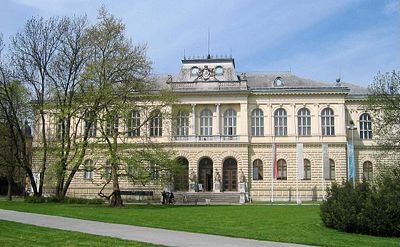
Slovenian Museum of Natural History
Encyclopedia

Slovenia
Slovenia , officially the Republic of Slovenia , is a country in Central and Southeastern Europe touching the Alps and bordering the Mediterranean. Slovenia borders Italy to the west, Croatia to the south and east, Hungary to the northeast, and Austria to the north, and also has a small portion of...
n national museum
Museum
A museum is an institution that cares for a collection of artifacts and other objects of scientific, artistic, cultural, or historical importance and makes them available for public viewing through exhibits that may be permanent or temporary. Most large museums are located in major cities...
with natural history
Natural history
Natural history is the scientific research of plants or animals, leaning more towards observational rather than experimental methods of study, and encompasses more research published in magazines than in academic journals. Grouped among the natural sciences, natural history is the systematic study...
, scientific, and educational contents. It is the oldest cultural and scientific Slovenian institution stemming from the Carniolian Museum founded in 1821. A museum with national, European, and world wide collections demonstrating the changes in biodiversity, the development of Natural History thought, as well as different techniques of collection and preparation of samples. Its research activities focus on natural heritage of Slovenia.
It is located in Ljubljana
Ljubljana
Ljubljana is the capital of Slovenia and its largest city. It is the centre of the City Municipality of Ljubljana. It is located in the centre of the country in the Ljubljana Basin, and is a mid-sized city of some 270,000 inhabitants...
, the capital of Slovenia. It is situated in the Center
Center (Ljubljana)
The Center District or simply Center is a city district in the center of Ljubljana, the capital of Slovenia. It has an area of about . Its major thoroughfares are Slovenian Street , Čop Street , Cankar Street , Wolf Street , Trubar Street , and Miklošič Street , and the major squares are Congress...
district of the city near the Tivoli Park, Parliament
Slovenian Parliament
The Slovenian Parliament is the informal designation of the general representative body of the Slovenian nation and the legislative body of the Republic of Slovenia....
and Opera House
Ljubljana opera house
Slovenian National Opera and Ballet Theatre is an opera house in Ljubljana, the capital of Slovenia. It serves as the national opera building of the country.-Opera in Slovenia:...
, sharing the building with National Museum of Slovenia
National Museum of Slovenia
The National Museum of Slovenia is located in Ljubljana, the capital of Slovenia. It is situated in the Center district of the city near the Tivoli Park....
.
History
The museum was founded in 1821 as the "Estate Museum of CarniolaCarniola
Carniola was a historical region that comprised parts of what is now Slovenia. As part of Austria-Hungary, the region was a crown land officially known as the Duchy of Carniola until 1918. In 1849, the region was subdivided into Upper Carniola, Lower Carniola, and Inner Carniola...
" . Five years later, the Austrian Emperor
Austrian Empire
The Austrian Empire was a modern era successor empire, which was centered on what is today's Austria and which officially lasted from 1804 to 1867. It was followed by the Empire of Austria-Hungary, whose proclamation was a diplomatic move that elevated Hungary's status within the Austrian Empire...
Francis II
Francis II, Holy Roman Emperor
Francis II was the last Holy Roman Emperor, ruling from 1792 until 6 August 1806, when he dissolved the Empire after the disastrous defeat of the Third Coalition by Napoleon at the Battle of Austerlitz...
decided to personally sponsor the museum and ordered its renaming to "Provincial Museum of Carniola". In 1882, the museum was renamed to "Provincial Museum of Carniola - Rudolfinium" in honour of the Crown Prince Rudolph.
After the establishment of the Kingdom of Serbs, Croats and Slovenes, the name was changed to "National Museum". In 1944, it was divided in the National Museum of Slovenia and the Slovenian Museum of Natural History (then known as the Museum of Natural Sciences).

